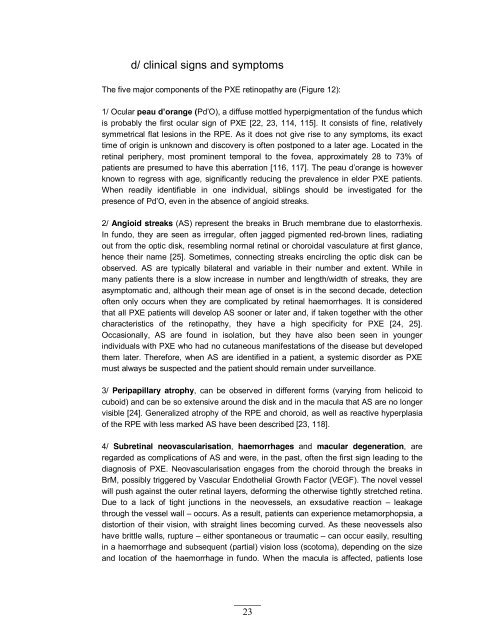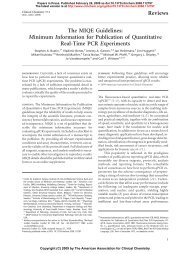This thesis is dedicated to my grandparents
This thesis is dedicated to my grandparents
This thesis is dedicated to my grandparents
Create successful ePaper yourself
Turn your PDF publications into a flip-book with our unique Google optimized e-Paper software.
d/ clinical signs and symp<strong>to</strong>ms<br />
The five major components of the PXE retinopathy are (Figure 12):<br />
1/ Ocular peau d’orange (Pd’O), a diffuse mottled hyperpigmentation of the fundus which<br />
<strong>is</strong> probably the first ocular sign of PXE [22, 23, 114, 115]. It cons<strong>is</strong>ts of fine, relatively<br />
symmetrical flat lesions in the RPE. As it does not give r<strong>is</strong>e <strong>to</strong> any symp<strong>to</strong>ms, its exact<br />
time of origin <strong>is</strong> unknown and d<strong>is</strong>covery <strong>is</strong> often postponed <strong>to</strong> a later age. Located in the<br />
retinal periphery, most prominent temporal <strong>to</strong> the fovea, approximately 28 <strong>to</strong> 73% of<br />
patients are presumed <strong>to</strong> have th<strong>is</strong> aberration [116, 117]. The peau d’orange <strong>is</strong> however<br />
known <strong>to</strong> regress with age, significantly reducing the prevalence in elder PXE patients.<br />
When readily identifiable in one individual, siblings should be investigated for the<br />
presence of Pd’O, even in the absence of angioid streaks.<br />
2/ Angioid streaks (AS) represent the breaks in Bruch membrane due <strong>to</strong> elas<strong>to</strong>rrhex<strong>is</strong>.<br />
In fundo, they are seen as irregular, often jagged pigmented red-brown lines, radiating<br />
out from the optic d<strong>is</strong>k, resembling normal retinal or choroidal vasculature at first glance,<br />
hence their name [25]. Sometimes, connecting streaks encircling the optic d<strong>is</strong>k can be<br />
observed. AS are typically bilateral and variable in their number and extent. While in<br />
many patients there <strong>is</strong> a slow increase in number and length/width of streaks, they are<br />
asymp<strong>to</strong>matic and, although their mean age of onset <strong>is</strong> in the second decade, detection<br />
often only occurs when they are complicated by retinal haemorrhages. It <strong>is</strong> considered<br />
that all PXE patients will develop AS sooner or later and, if taken <strong>to</strong>gether with the other<br />
character<strong>is</strong>tics of the retinopathy, they have a high specificity for PXE [24, 25].<br />
Occasionally, AS are found in <strong>is</strong>olation, but they have also been seen in younger<br />
individuals with PXE who had no cutaneous manifestations of the d<strong>is</strong>ease but developed<br />
them later. Therefore, when AS are identified in a patient, a systemic d<strong>is</strong>order as PXE<br />
must always be suspected and the patient should remain under surveillance.<br />
3/ Peripapillary atrophy, can be observed in different forms (varying from helicoid <strong>to</strong><br />
cuboid) and can be so extensive around the d<strong>is</strong>k and in the macula that AS are no longer<br />
v<strong>is</strong>ible [24]. Generalized atrophy of the RPE and choroid, as well as reactive hyperplasia<br />
of the RPE with less marked AS have been described [23, 118].<br />
4/ Subretinal neovascular<strong>is</strong>ation, haemorrhages and macular degeneration, are<br />
regarded as complications of AS and were, in the past, often the first sign leading <strong>to</strong> the<br />
diagnos<strong>is</strong> of PXE. Neovascular<strong>is</strong>ation engages from the choroid through the breaks in<br />
BrM, possibly triggered by Vascular Endothelial Growth Fac<strong>to</strong>r (VEGF). The novel vessel<br />
will push against the outer retinal layers, deforming the otherw<strong>is</strong>e tightly stretched retina.<br />
Due <strong>to</strong> a lack of tight junctions in the neovessels, an exsudative reaction – leakage<br />
through the vessel wall – occurs. As a result, patients can experience metamorphopsia, a<br />
d<strong>is</strong><strong>to</strong>rtion of their v<strong>is</strong>ion, with straight lines becoming curved. As these neovessels also<br />
have brittle walls, rupture – either spontaneous or traumatic – can occur easily, resulting<br />
in a haemorrhage and subsequent (partial) v<strong>is</strong>ion loss (sco<strong>to</strong>ma), depending on the size<br />
and location of the haemorrhage in fundo. When the macula <strong>is</strong> affected, patients lose<br />
23





